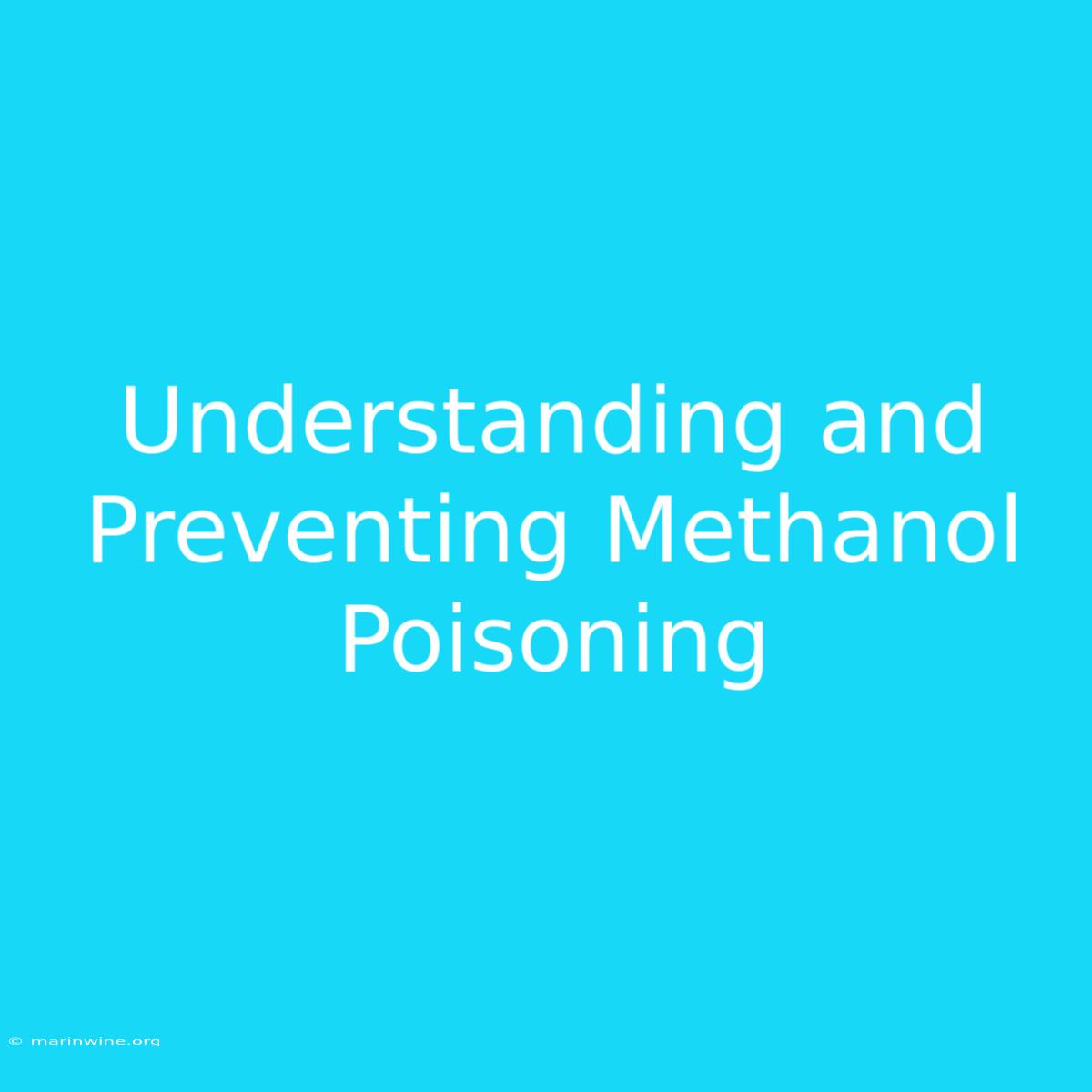Understanding and Preventing Methanol Poisoning
Editor's Note: Methanol poisoning remains a significant public health concern. This article provides crucial information on understanding and preventing this dangerous condition.
Why This Topic Matters
Methanol poisoning, a severe and potentially fatal condition, results from ingesting, inhaling, or absorbing methanol (wood alcohol) into the body. Understanding its causes, symptoms, and prevention strategies is crucial for public health and safety. This article will explore the sources of methanol exposure, the mechanisms of toxicity, the clinical presentation of poisoning, and effective preventative measures. Knowing the risks and recognizing the signs can be life-saving.
Key Takeaways
| Point | Description |
|---|---|
| Sources of Methanol | Industrial solvents, fuels, contaminated alcohol, certain cleaning products |
| Symptoms | Nausea, vomiting, headache, blurred vision, blindness, seizures, respiratory failure |
| Treatment | Fomepizole or ethanol administration, supportive care |
| Prevention | Avoid consuming unlabelled or homemade alcohol, ensure proper ventilation in industrial settings |
Methanol Poisoning
Introduction
Methanol poisoning is a serious concern, particularly in regions with unregulated alcohol production or industrial settings with inadequate safety protocols. The insidious nature of methanol poisoning stems from its initial symptoms often being mild and easily mistaken for other illnesses, delaying crucial treatment.
Key Aspects
Methanol itself isn't directly toxic. The body metabolizes methanol into formaldehyde and formic acid, which are highly toxic and cause cellular damage, particularly affecting the optic nerve and central nervous system.
Detailed Analysis
The severity of methanol poisoning depends on the amount ingested and the individual's metabolic rate. Formaldehyde causes irritation of the mucous membranes, leading to nausea, vomiting, and headache. Formic acid, the more toxic metabolite, is responsible for the serious complications, including blindness (optic neuritis), metabolic acidosis, and neurological damage. Severe cases can lead to respiratory failure, coma, and death. Comparisons to other alcohol poisonings highlight the unique and more severe consequences of methanol. Ethanol, for example, while also toxic in large quantities, doesn't cause the same level of irreversible organ damage.
Understanding the Risks: Contaminated Alcohol
Introduction
Contaminated alcohol is a major source of methanol poisoning, especially in areas lacking proper alcohol regulation.
Facets
- Roles: Informal distilleries and unregulated alcohol production often lack quality control, leading to methanol contamination.
- Examples: Homemade spirits, illicitly produced alcohol, and alcohol purchased from untrusted sources.
- Risks: Blindness, permanent neurological damage, death.
- Mitigations: Only consume alcohol from reputable sources with clear labeling.
- Impacts: Significant morbidity and mortality, especially in low-income communities.
Summary
The risk of methanol poisoning from contaminated alcohol highlights the critical need for stringent regulations and public awareness campaigns about the dangers of consuming unverified alcohol products.
Industrial Exposure to Methanol
Introduction
Industrial exposure to methanol poses significant risks to workers handling methanol-containing products.
Further Analysis
Workers in industries like manufacturing, automotive repair, and cleaning should use appropriate personal protective equipment (PPE) such as respirators, gloves, and eye protection. Proper ventilation is crucial to minimize inhalation exposure. Regular health monitoring for workers exposed to methanol is essential for early detection of potential problems.
Closing
Strict adherence to safety protocols in industrial settings is paramount to prevent methanol poisoning. Regular training and access to appropriate PPE can significantly reduce the risk.
People Also Ask (NLP-Friendly Answers)
Q1: What is methanol poisoning?
- A: Methanol poisoning is a severe condition caused by ingesting, inhaling, or absorbing methanol, leading to the formation of toxic metabolites that damage the body, especially the eyes and nervous system.
Q2: Why is methanol poisoning important?
- A: Methanol poisoning is important because it can cause permanent blindness, neurological damage, and death. Understanding it helps in prevention and early intervention.
Q3: How can methanol poisoning benefit me? (This question is irrelevant; rephrase is needed) How can I protect myself from methanol poisoning?
- A: Protect yourself by only drinking alcohol from reputable sources, using proper ventilation in industrial settings, and wearing appropriate PPE when handling methanol.
Q4: What are the main challenges with methanol poisoning treatment?
- A: Challenges include delayed diagnosis due to nonspecific initial symptoms and the need for specialized treatment (fomepizole or ethanol).
Q5: How to get started with preventing methanol poisoning?
- A: Start by only consuming commercially produced, labeled alcohol and ensuring proper ventilation and PPE usage in relevant work environments.
Practical Tips for Preventing Methanol Poisoning
Introduction
These practical tips can help you reduce your risk of methanol poisoning.
Tips
- Only consume alcohol from reputable sources: Check labels and avoid homemade or unlabeled alcohol.
- Use proper ventilation when working with methanol: Ensure adequate airflow in industrial settings.
- Wear appropriate PPE when handling methanol: Gloves, respirators, and eye protection are crucial.
- Immediately seek medical attention if you suspect methanol poisoning: Time is critical for effective treatment.
- Educate yourself and others about the dangers of methanol: Raise awareness to prevent accidental exposure.
- Store methanol safely and securely: Keep it out of reach of children and away from food and drinks.
- Report any suspected methanol contamination to the authorities: Help prevent further harm to others.
- Follow all safety guidelines provided by employers or manufacturers: This includes proper handling, storage, and disposal procedures.
Summary
By following these practical tips, you can significantly reduce your risk of methanol poisoning and protect yourself and others.
Transition
Understanding the dangers of methanol poisoning and practicing preventative measures are vital for ensuring safety.
Summary (Ringkasan)
Methanol poisoning is a serious health concern with potentially devastating consequences. Avoiding unlabeled or homemade alcohol, using proper safety precautions in industrial settings, and seeking immediate medical attention if exposure is suspected are crucial for prevention and treatment.
Call to Action (CTA)
Learn more about workplace safety and chemical handling at [link to relevant resource]. Share this article to help spread awareness about the dangers of methanol poisoning.
Hreflang Tags
(Hreflang tags would be added here based on the specific language versions of the article)

